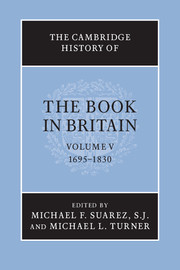Book contents
- Frontmatter
- Introduction
- PART I THE QUANTITY AND NATURE OF PRINTED MATTER
- PART II ECONOMIC, LEGAL AND CULTURAL CONTEXTS
- PART III THE TECHNOLOGIES AND AESTHETICS OF BOOK PRODUCTION
- 7 The technologies of printing
- 8 The industrialization of the paper trade
- 9 A year’s work in the London printing house of the Bowyers
- 10 Book illustration and the world of prints
- 11 The morphology of the page
- 12 Bookbinding in the eighteenth century
- PART IV THE BOOK TRADE AND ITS MARKETS
- V BOOKS AND THEIR READERS
- Abbreviations used in bibliography
- Bibliography
- Index
- Frontispiece
- Plate section
- References
10 - Book illustration and the world of prints
from PART III - THE TECHNOLOGIES AND AESTHETICS OF BOOK PRODUCTION
Published online by Cambridge University Press: 28 September 2010
- Frontmatter
- Introduction
- PART I THE QUANTITY AND NATURE OF PRINTED MATTER
- PART II ECONOMIC, LEGAL AND CULTURAL CONTEXTS
- PART III THE TECHNOLOGIES AND AESTHETICS OF BOOK PRODUCTION
- 7 The technologies of printing
- 8 The industrialization of the paper trade
- 9 A year’s work in the London printing house of the Bowyers
- 10 Book illustration and the world of prints
- 11 The morphology of the page
- 12 Bookbinding in the eighteenth century
- PART IV THE BOOK TRADE AND ITS MARKETS
- V BOOKS AND THEIR READERS
- Abbreviations used in bibliography
- Bibliography
- Index
- Frontispiece
- Plate section
- References
Summary
The use of prints to illustrate books was one branch of a wide-ranging business in the production of printed pictures. Away from the context of books, prints are usually thought of as decorative objects, but in the eighteenth century many were made for practical use. There were playing cards and printed fans, children’s games and watchpapers, but there were also prints used by craftsmen and by amateurs teaching themselves a skill. Such were the many cheap ‘books of ornament’ and ‘drawing books’ listed in printsellers’ catalogues – usually a handful of small printed sheets stitched together with or without a blue wrapper. Prints were used and consumed (literally destroyed through use) as well as admired and studied.
However, the most valuable and prestigious prints, along with many cheaper ones, were sold as art objects. Presented as individual sheets or in small sets, they were usually destined for a decorative role – to be framed or otherwise displayed on a wall. Alternatively, individual prints or sets of prints might be pasted or bound in volumes. Such volumes might contain a collection of portraits, views of a country or city, the works of an artist, or a compilation of political or social satires. Print collections were usually kept in volumes. Large prints on copperplate paper (usually heavier and sturdier than that employed for letterpress) were sometimes bound into albums; other prints were glued to sheets of sugar paper, often coloured blue. Albums of prints were intended to serve as sources of information for study, or for leisurely perusal to amuse company on a rainy day in the library or closet.
- Type
- Chapter
- Information
- The Cambridge History of the Book in Britain , pp. 230 - 247Publisher: Cambridge University PressPrint publication year: 2009
References
- 2
- Cited by



